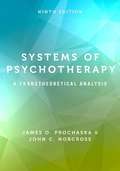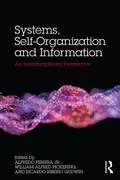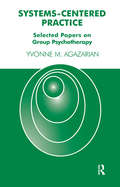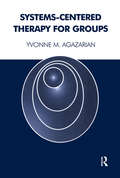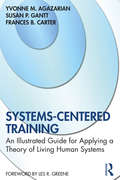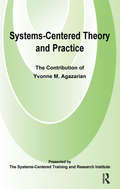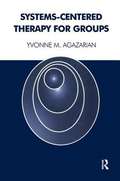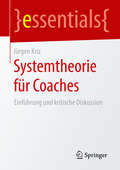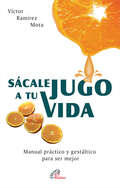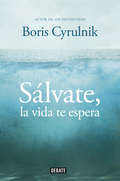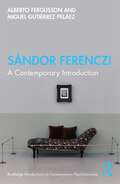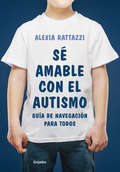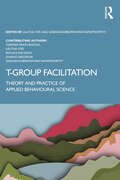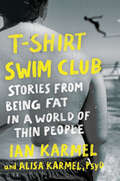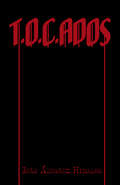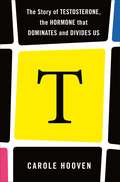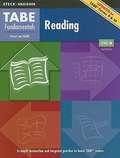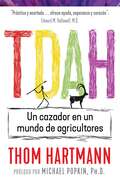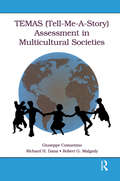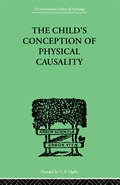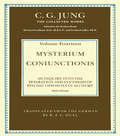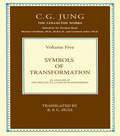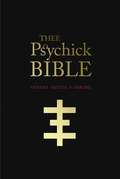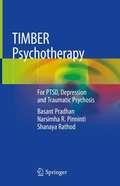- Table View
- List View
Systems of Psychotherapy: A Transtheoretical Analysis
by James O. Prochaska; John C. NorcrossComprehensive, systematic, and balanced, Systems of Psychotherapy uses a wealth of clinical cases to help readers understand a wide variety of psychotherapies - including psychodynamic, existential, experiential, interpersonal, exposure, behavioral, cognitive, third wave, systemic, multicultural, and integrative. The ninth edition of this landmark text thoroughly analyzes 15 leading systems of psychotherapy and briefly surveys another 32, providing students and practitioners with a broad overview of the discipline. <p><p> The book explores each system's theory of personality, theory of psychopathology, and resulting therapeutic process and therapy relationship. Through these explorations the authors clearly demonstrate how psychotherapy systems agree on the processes producing change while diverging on the elements in need of change. Additionally, the authors present cogent criticisms of each approach from cognitive-behavioral, psychoanalytic, humanistic, cultural, and integrative perspectives. This ninth edition features updated meta-analytic reviews of the effectiveness of each system, new sections on Lacanian analysis, mentalization therapy, and psychotherapy with gender nonconforming people, as well as new sections and updates throughout the text.
Systems, Self-Organisation and Information: An Interdisciplinary Perspective
by Pereira Junior Alfredo William A Pickering Ricardo Ribeiro GudwinComplex system studies are a growing area of central importance to a wide range of disciplines, ranging from physics to politics and beyond. Adopting this interdisciplinary approach, Systems, Self-Organisation and Information presents and discusses a range of ground-breaking research in complex systems theory. Building upon foundational concepts, the volume introduces a theory of Self-Organization, providing definitions of concepts including system, structure, organization, functionality, and boundary. Biophysical and cognitive approaches to Self-Organization are also covered, discussing the complex dynamics of living beings and the brain, and self-organized adaptation and learning in computational systems. The convergence of Peircean philosophy with the study of Self-Organization also provides an original pathway of research, which contributes to a dialogue between pragmatism, semeiotics, complexity theory, and self-organizing systems. As one of the few interdisciplinary works on systems theory, relating Self-Organization and Information Theory, Systems, Self-Organisation and Information is an invaluable resource for researchers and postgraduate students interested in complex systems theory from related disciplines including philosophy, physics, and engineering.
Systems-Centered Practice: Selected Papers on Group Psychotherapy
by Yvonne M. AgazarianSystems-Centered Practice presents a series of papers that trace the development of the theory of living human systems between 1987 and 2002. As the theory develops, so do the methods and techniques that put it into practice. The book also describes in detail the connection between the hierarchy of defence modification and the specific phases of system development that determine readiness for change. The papers in this volume contribute to our knowledge of the permeability of the boundaries between clinical and social psychology through the investigation of living human systems, and of systems-centered group and individual therapy. The author's considerable body of work constitutes a blend of creativity and learning of the highest order.
Systems-Centered Therapy for Groups
by Yvonne M. AgazarianSystems-Centered Therapy (SCT) is an innovative approach to psychotherapy that synthesizes a finely-tuned awareness of the defensive roles of anxiety and depression, with an analysis of the phases of group development. This volume introduces the author's theory of living human systems and explicitly maps out its use in a structured treatment model applicable to work with any population. In rich conceptual detail, the volume presents SCT as a powerful modality that enables clients to safely "sit on the edge of the unknown" and transform their ways of relating to themselves and each other. It will be received with interest by all practitioners and trainees in group and individual psychotherapy.
Systems-Centered Therapy: Clinical Practice with Individuals, Families and Groups
by Yvonne M. AgazarianSystems-centered therapy (SCT) brings an innovative approach to clinical practice. Developed by the author, SCT introduces a theory and set of methods that put systems ideas into practice. The collection of articles in this book illustrates the array of clinical applications in which SCT is now used. Each chapter introduces particular applications of SCT theory or methods with specific examples from practice that help the theory and methods come alive for the reader across a variety of clinical contexts. This book will be especially useful for therapists and clinical practitioners interested in sampling SCT, for those who learn best with clinical examples, and for anyone with a serious interest in learning the systems-centered approach.
Systems-Centered Training: An Illustrated Guide for Applying a Theory of Living Human Systems
by Yvonne M. Agazarian Susan P. Gantt Frances B. CarterThis illustrated book shows how "thinking" systems offer new ways of seeing people which can help us see and do things differently. The authors describe how a theory of living human systems was developed and even recently revised. This major revision led to a theory of the person-as-a-system and its role-systems map that helps us see which system in us and in others is running the show. The authors illustrate how life force energy fuels the hierarchy of living human systems and how theory and practice with role-systems can be useful in everyday life. They begin with describing how they have used the new illustrations as a map to locate the contexts of our roles. Using this map has also enabled the authors to identify the role-systems and explore the territory of ourselves and our groups in new ways that deepened our understanding of roles and role locks. This book illustrates systems-centered therapy and training (SCT) theory by offering a practical theory to guide group psychotherapists, leaders and consultants in working with group dynamics.
Systems-Centred Theory and Practice: The Contribution of Yvonne Agazarian
by Yvonne M. AgazarianSystems-centered therapy (SCT) brings an innovative approach to clinical practice. Developed by the author, SCT introduces a theory and set of methods that put systems ideas into practice. The collection of articles in this book illustrates the array of clinical applications in which SCT is now used. Each chapter introduces particular applications of SCT theory or methods with specific examples from practice that help the theory and methods come alive for the reader across a variety of clinical contexts. This book will be especially useful for therapists and clinical practitioners interested in sampling SCT, for those who learn best with clinical examples, and for anyone with a serious interest in learning the systems-centered approach.
Systems: Centered Therapy For Groups
by Yvonne M. AgazarianIn living human systems and explicitly maps out its use in a structured treatment model applicable to work with any population. In rich conceptual detail, the volume presents SCT as a powerful modality that enables clients to safely "sit on the edge of the unknown" and transform their ways of relating to themselves and each other. It will be received with interest by all practitioners and trainees in group and individual psychotherapy.
Systemtheorie für Coaches: Einführung und kritische Diskussion (essentials)
by Jürgen KrizDas essential bietet eine prägnante Übersicht über zentrale Konzepte und Begrifflichkeiten, die häufig im Kontext systemischen Coachings vorkommen. Den Ausführungen liegt ein Ansatz zugrunde, der auf dem Boden interdisziplinärer Systemtheorie (,,Synergetik") als ,,Personzentrierte Systemtheorie" bekannt ist. Die dort entwickelten Konzepte und Prinzipien ermöglichen ein systemtheoretisch begründetes und konsistentes Verständnis bezüglich der Entstehung, Stabilität und Veränderung von Problemstrukturen. Damit lassen sich zentrale Aspekte und Fragen, die im Bereich des Coachings auftreten, auf systemtheoretische Weise betrachten, was es ermöglicht, das Handlungspotenzial im systemischen Coaching in konsistenter Weise weiterzuentwickeln und zu vertiefen.
Sácale jugo a tu vida
by Vîctor Ramîrez Mota"Encontrarás tips para empezar a cambiar tu forma de pensar. Los cambios son buenos cuando se trata de buscar la felicidad, el autor nos propone identificar lasactitudes a cambiar y nos asegura que cambiaremos la manera de sentir y consecuentemente la manera de tratar a los demás."
Sálvate, la vida te espera
by Boris CyrulnikUn lúcido análisis sobre la memoria, la imaginación y los recuerdos a través de una historia real de superación, pero también sobre el trauma, sobre las heridas y la sanación. Boris Cyrulnik, eminente psiquiatra y psicólogo, profundo conocedor de la mente, vivió una infancia traumática. Separado de sus padres, que fueron asesinados en campos de concentración, vivió como un fugitivo, escondido en casas de familias de acogida y en orfanatos. Como la mayoría de los supervivientes al volver de los campos, y como la mayoría de personas que han vivido situaciones traumáticas durante su infancia, Boris Cyrulnik se refugió en el silencio después de la guerra. Sálvate, la vida te espera es un libro sobre el trauma, sobre las heridas y la sanación, sobre la imposibilidad de contar en un mundo en el que nadie quiere escuchar. Sobre la indiferencia que mata y los vínculos que salvan, sobre las ilusiones del recuerdo, sobre ese fenómeno extraño que se llama memoria, que no es la reconstrucción del pasado sino su representación, y que no cuenta la verdad histórica de los hechos sino otra verdad, todavía más real: la de la persona que recuerda. A través del relato de su propia historia, Boris Cyrulnik ayuda a todos aquellos que intentan escapar de un pasado marcado por el dolor. Así empieza Sálvate, la vida te espera: «He nacido dos veces. La primera vez no estaba allí. Mi cuerpo vino al mundo el 26 de julio de 1937 en Burdeos. Me lo han contado, y estoy obligado a creerlo ya que no guardo ningún recuerdo. Mi segundo nacimiento está grabado en mi memoria. Una noche fui arrestado por unos hombres armados que rodeaban mi cama. Venían a buscarme para matarme. Mi historia nace aquella noche.» Reseñas:«Los comentarios sobre el libro de Cyrulnik no aportan nada. Hay que leerlo. Absolutamente. "Mi vida mental se había detenido a los dos años,cuando mi madre, tras el alistamiento de mi padre en el ejército francés, se quedó sola y angustiada por la idea de su inminente detención. Después siguieron unos años de persecución, de trato constante con la muerte y de aislamiento sensorial. Los desgarros afectivos, repetidos una y otra vez, la prohibición de salir o de ir a la escuela, el sentimiento de ser un monstruo hicieron imposible el menor desarrollo. No sufrí durante estas agresiones ya que mi alma estaba paralizada. Uno no siente nada cuando está en 'agonía psíquica', se respira un poco, y ya está." ¿Qué más añadir? ¿Qué más decir?»Valérie Trierweiler, Paris-Match «Boris Cyrulnik abre las puertas de su "cripta", de su caja de Pandora de la que emerge un relato autobiográfico conmovedor... Reconstruye su pasado con sus abismos, sus sufrimientos, sus recuerdos engañosos, sus dudas, sus zonas sombrías... Como un investigador, reconstruye el puzle de su vida. Boris Cyrulnik es un gran resiliente. A través de este libro, se toma a sí mismo como objeto de estudio. Intentando discernir entre lo verdadero y lo falso, acorrala sus recuerdos. Algunos reales, otros enriquecidos, inconscientemente, para dar coherencia a lo impensable, para poder sobrevivir.»Le Monde
Sándor Ferenczi: A Contemporary Introduction (Routledge Introductions to Contemporary Psychoanalysis)
by Miguel Gutiérrez-Peláez Alberto FergussonThis book aims to present an up-to-date introduction and critical study of one of the most important psychoanalysts of all times, Sándor Ferenczi. The book presents Ferenczi as a person; his discovery of psychoanalysis and his relationship with Freud; the theoretical and clinical novelties he introduced to psychoanalysis; his deep political and social commitment, striving for the democratization of psychoanalysis; and the great relevance of his thought and perspective for the future. It also talks about his repression in the history of psychoanalysis as well as his influence in the following generations of psychoanalysts. The reader will be presented with the most relevant historical milestones and concepts, with new insights regarding some of Ferenczi’s most fundamental ideas (such as his trauma theory, his technical innovations or his developments regarding the end of analysis), as well as an informed viewpoint of his legacy, the contemporary readings of his work and the institutions and associations that continue following the path traced by l’enfant terrible of psychoanalysis. This book will be of interest both for the novel reader who has had none or scarce contact with the person and/or work of Sándor Ferenczi, as well as to the psychoanalysts, clinicians and scholars, who have a deeper contact and understanding of the work of the Hungarian analyst.
Sé amable con el autismo: Manual de navegación para todos
by Alexia RattazziLa doctora Alexia Rattazzi, especialista en autismo, propone un camino diferente y posible para abordar una de las condiciones más complejas y difíciles de diagnosticar y de tratar. Uno de cada cincuenta y nueve niñxs tiene alguna condición dentro del espectro autista (CEA). Pero ¿qué es el autismo? ¿Cómo se diagnostica? ¿Se puede prevenir? ¿Qué rol tiene la Salud Pública? La doctora Alexia Rattazzi aborda cada una de estas preguntas (y muchas más) para explicarnos porqué el autismo no es una enfermedad, sino una condición. Cuándo es necesario brindar apoyo y cuál es la forma de contención que las personas más cercanas pueden proporcionar. Sé amable con el autismo no solo ofrece definiciones y abordajes, también demuestra la importancia de la calidad humana cuando se trata de acompañar a personas con CEA y propone herramientas para navegar en las aguas de la diversidad. Los valores, las creencias y los mitos forman parte de la sociedad que habitamos y, en este sentido, las personas pueden ser un instrumento transformador de la realidad de otros. Actos tan sencillos como sonreír, ser pacientes y creer en el potencial del otro pueden cambiar el presente y el futuro de cualquier persona, tenga o no una discapacidad. Este libro es una invitación a cambiar la mirada sobre el autismo y un estímulo para transformar el mundo en un lugar más inclusivo para todxs.
T-Group Facilitation: Theory and Practice of Applied Behavioural Science
by Lalitha Iyer Sharad Sakorkar Sankarasubramanyan Ramamoorthy Tejinder Singh Bhogal Renuka Raj SinghThis book offers the core conceptual base for the practice of T-Group facilitation. Drawing from the fields of psychology, social psychology, sociology, diversity studies and Indian philosophical thoughts, this book is a great resource for enhancing the practice of T-Group facilitation, for both budding and established facilitators. It covers a wide range of theories on human development, self-awareness, interpersonal interactions, groups and change. Individual and group identities, diversity, inclusion and social hierarchies are explored in detail here. The authors offer a model of T-Group facilitation based on 50 years of experience within the Indian Society for Applied Behavioural Science (ISABS). This model is useful not only for fellow practitioners of T-Groups but also for anyone engaged in facilitating groups, organizations and communities globally. This book helps one to reflect, develop and sharpen one’s competencies, values and ethics in this field. The chapters are embedded with activities, quizzes, case studies and exercises to facilitate a deeper understanding of the various elements used in the book. This book will be of interest to students, teachers and practitioners of psychology, social psychology, management studies and organizational development. It will also be useful for T-Group facilitators, facilitators of experiential groups and related fields.
T-Shirt Swim Club: Stories from Being Fat in a World of Thin People
by Ian Karmel Alisa KarmelComedian Ian Karmel, with help from his sister, Dr. Alisa Karmel, opens up about the daily humiliations of being fat and why it&’s so hard to talk about something so visible.&“As charming and funny as it is poignant and thoughtful.&”—Roxane Gay, author of Hunger: A Memoir of (My) BodyIan Karmel has weighed eight pounds and he has weighed 420 pounds and right now he&’s almost exactly in between the two, but this book is not a weight-loss book. It&’s about being a fat person in a skinny world. It&’s about gym class and football practice, about chicken wings and juice cleanses, about airplane seats and roller coasters, about fat jokes and Jabba the Hutt, about crying in the Big and Tall section and the joys of being a sneakerhead, about prediabetes and gout, and about realizing that you actually don&’t want to eat yourself to death and hoping it&’s not too late.This book also includes a &“What Now?&” section from Ian&’s sister, Alisa, who herself cycled through so many fad diets that she eventually pursued a master&’s in nutrition and a doctorate in psychology with the goal of changing the contemporary narrative around fatness.Ian and Alisa Karmel grew up fat. As kids, they never talked about it. They were too busy fighting over the last SnackWell&’s Devil&’s Food cookie. Now, decades later, having both turned into fat adults who eventually figured out how to get their health under control, they are finally ready to unpack the impact that their weight has had on them.For them, the T-Shirt Swim Club is meant to be a place of support for anyone who struggles with weight issues. A place of care and candor, free of shame. A place to not deny or avoid the emotions you feel, the experiences you go through, the embarrassment, the anger, the resentment. T-Shirt Swim Club is about being a fat person and how the world treats fat people—but also an acknowledgment that maybe it doesn&’t always have to feel quite so lonely.
T.O.C. ADOS
by Iván Álvarez HidalgoMe llamo Iván, tengo un trastorno obsesivo compulsivo (un trastorno muy peculiar) y escribo mi autobiografía, cómo sobrellevar la enfermedad, tanto interiormente como exteriormente, ya que he estudiado psicología y hablo sobre la psicología del trastorno obsesivo compulsivo y general, psicosocial, filosofía, aforismos, sentencias morales, proverbios orientales, valores y sobre el tema social del siglo XXI.
T: The Story of Testosterone, the Hormone that Dominates and Divides Us
by Carole HoovenThrough riveting personal stories and the latest research, Harvard evolutionary biologist Carole Hooven shows how testosterone drives the behavior of the sexes apart and how understanding the science behind this hormone is empowering for all.Since antiquity—from the eunuchs in the royal courts of ancient China to the booming market for “elixirs of youth” in nineteenth-century Europe—humans have understood that typically masculine behavior depends on testicles, the main source of testosterone in males. Which sex has the highest rates of physical violence, hunger for status, and desire for a high number of sex partners? Just follow the testosterone.Although we humans can study and reflect on our own behavior, we are also animals, the products of millions of years of evolution. Fascinating research on creatures from chimpanzees to spiny lizards shows how high testosterone helps males out-reproduce their competitors. And men are no exception.While most people agree that sex differences in human behavior exist, they disagree about the reasons. But the science is clear: testosterone is a potent force in human society, driving the bodies and behavior of the sexes apart. But, as Hooven shows in T, it does so in concert with genes and culture to produce a vast variety of male and female behavior. And, crucially, the fact that many sex differences are grounded in biology provides no support for restrictive gender norms or patriarchal values. In understanding testosterone, we better understand ourselves and one another—and how we might build a fairer, safer society.
TABE Fundamentals: Reading, Level M (2nd edition)
by Steck-VaughnTABE stands for the Tests of Adult Basic Education. These paper-and-pencil tests, published by McGraw-Hill, measure your progress on basic skills. There are five tests in all: Reading, Mathematics Computation, Applied Mathematics, Language, and Spelling.
TDAH: Un cazador en un mundo de agricultores
by Thom Hartmann• Explica que las personas con TDAH no tienen trastornos, sino que son &“cazadores en un mundo de agricultores&”; es decir, poseen un conjunto de habilidades mentales únicas que les habrían permitido prosperar en una sociedad de cazadores-recolectores • Ofrece métodos y prácticas concretas y sin fármacos para ayudar a los &“cazadores&”, y a sus padres, maestros y administradores, a aceptar sus diferencias, fomentar la creatividad y encontrar el éxito en la escuela, el trabajo y el hogar • Revela cómo algunas de las personas más exitosas del mundo pueden ser etiquetadas como cazadores con TDAH, incluidos Benjamin Franklin, Thomas Edison y Andrew CarnegieCon un 10% de los niños del mundo occidental que muestra indicios de tener trastorno por déficit de atención con hiperactividad, o TDAH, y un número creciente de adultos autodiagnosticándose, después de décadas de lucha, debemos plantear la pregunta: ¿cómo pudo cometer tal &“error&” la naturaleza? En este libro, Thom Hartmann explica que las personas con TDAH no son anormales, desordenadas o disfuncionales, sino simplemente &“cazadores en un mundo de agricultores&”. A menudo muy creativos y resueltos en la búsqueda de un objetivo elegido por ellos mismos, las personas con síntomas de TDAH poseen un conjunto de habilidades mentales únicas, las cuales les habrían permitido prosperar en una sociedad de cazadores-recolectores. Como cazadores, habrían estado constantemente escaneando su entorno, buscando comida o amenazas (distracción); habrían tenido que actuar sin vacilación (impulsividad) y amado el entorno de alta estimulación y lleno de riesgos del campo de caza. Con nuestras escuelas públicas, lugares de trabajo de oficina y fábricas estructuradas, aquellos que heredan un excedente de &“habilidades de cazador&” a menudo se sienten frustrados en un mundo que no los comprende ni los apoya. Como muestra Hartmann, al reformular nuestra visión del TDAH, podemos comenzar a verlo no como un trastorno, sino como una diferencia y, en cierto modo, una ventaja. El autor revela cómo algunas de las personas más exitosas del mundo pueden ser etiquetadas como cazadores de TDAH, aparte de proporcionar prácticas y métodos concretos, sin fármacos, para ayudar a los cazadores, y a sus padres, maestros y gerentes, a aceptar sus diferencias, fomentar la creatividad y encontrar el éxito en la escuela, en el trabajo y en casa. Además de ofrecer una guía de &“supervivencia&” para ayudar a afinar sus habilidades naturales, en lugar de suprimirlas, Hartmann muestra que cada mente, ya sea cazadora, agricultora o en algún punto intermedia, tiene valor y un gran potencial a la espera de ser aprovechado.
TEMAS (Tell-Me-A-Story) Assessment in Multicultural Societies
by Richard H. Dana Giuseppe Costantino Robert G. MalgadyEthnic minority children now comprise over 75 percent of students in 100 of the largest cities in the United States. However, these students have not been given equal access to, nor benefited from, the contemporary mental health system as have their non-minority peers. TEMAS (Tell-Me-A-Story) Assessment in Multicultural Societies examines the health/mental care system in which professional service providers, including psychologists, labor to offer quality care for youth in the United States. The authors ardently support the use of the TEMAS assessment instrument as a useful tool for diagnosis of all youngsters, particularly its use on the growing population of minority children and adolescents.Part I presents a rationale and context for employing TEMAS. Introductory chapters describe the mental health status of the population at-risk, as well as systems of care for youth where assessment and intervention are components. Topics to follow highlight a history of positive TEMAS test reviews with the detail required by instructors for preparing dedicated TEMAS courses. The volume thoroughly outlines cross-cultural studies and illustrates case examples of European-American, Hispanic/Latino, Asian-American, and forensic studies.TEMAS (Tell-Me-A-Story) Assessment in Multicultural Societies brings practical insight to instructors who teach standard assessment courses; clinicians, counselors, and school psychologists; assessment specialists; and administrators concerned with mental health services designed for children and adolescents.
THE CHILD'S CONCEPTION OF Physical CAUSALITY (International Library Of Psychology Ser.)
by Piaget, JeanOur encounters with the physical world are filled with miraculous puzzles-wind appears from somewhere, heavy objects (like oil tankers) float on oceans, yet smaller objects go to the bottom of our water-filled buckets. As adults, instead of confronting a whole world, we are reduced to driving from one parking garage to another. The Child's Conception of Physical Causality, part of the very beginning of the ground-breaking work of the Swiss naturalist Jean Piaget, is filled with creative experimental ideas for probing the most sophisticated ways of thinking in children. The strength of Piaget's research is evident in this collection of empirical data, systematically organized by tasks that illuminate how things work. Piaget's data are remarkably rich. In his new introduction, Jaan Valsiner observes that Piaget had no grand theoretical aims, yet the book's simple power cannot be ignored. Piaget's great contribution to developmental psychology was his "clinical method"-a tactic that integrated relevant aspects of naturalistic experiment, interview, and observation. Through this systematic inquiry, we gain insight into children's thinking. Reading Piaget will encourage the contemporary reader to think about the unity of psychological phenomena and their theoretical underpinnings. His wealth of creative experimental ideas probes into the most sophisticated ways of thinking in children. Technologies change, yet the creative curiosity of children remains basically unhindered by the consumer society. Piaget's data preserve the reality of the original phenomena. As such, this work will provide a wealth of information for developmental psychologists and those involved in the field of experimental science. Jean Piaget (1896-1980) is known for investigations of thought processes. He was professor at Geneva University (1929-1954) and director of the International Center for Epistemology (1955-1980). He is the author of The Language and Thought of the Child, Judgment and Reasoning in the Child, The Origin of Intelligence in Children, and The Early Growth of Logic in the Child. Jaan Valsiner is professor of psychology at Clark University, and a recognized authority on the life and work of Piaget.
THE COLLECTED WORKS OF C. G. JUNG: An Inquiry into the Separation and Synthesis of Psychic Opposites in Alchemy (Collected Works of C.G. Jung #No. 14)
by C.G. JungMysterium Coniunctionis was first published in the Collected Works of C.G. Jung in 1963. For this second edition of the work, numerous corrections and revisions have been made in cross-references to other volumes of the Collected Works now available and likewise in the Bibliography. Mysterium Coniunctionis was Jung's last work of book length and gives a final account of his lengthy researches in alchemy. It was Jung's empirical discovery that certain key problems of modern man were prefigures in what t he alchemists called their 'art' or 'process'. Jung maintained that 'the world of alchemical symbols does not belong to the rubbish heap of the past, but stands in a very real and living relationship to our most recent discoveries concerning the psychology of the unconscious'. The volume includes ten plates, a Bibliography, an Index, and an Appendix of original Latin and Greek texts quoted in the work.
THE COLLECTED WORKS OF C. G. JUNG: Symbols Of Transformation (Collected Works of C. G. Jung #46)
by C.G. JungIn 1911 Jung published a book of which he says: '...it laid down a programme to be followed for the next few decades of my life.' It was vastly erudite and covered innumerable fields of study: psychiatry, psychoanalysis, ethnology and comparitive religion amongst others. In due course it became a standard work and was translated into French, Dutch and Italian as well as English, in which language it was given the well-known but somewhat misleading title of The Psychology of the Unconscious. In the Foreword to the present revised edition which first appeared in 1956, Jung says: '...it was the explosion of all those psychic contents which could find no room, no breathing space, in the constricting atmosphere of Freudian psychology... It was an attempt, only partially successful, to create a wider setting for medical psychology and to bring the whole of the psychic phenomena within its purview.' For this edition, appearing ten years after the first, bibliographical citations and entries have been revised in the light of subsequent publications in the Collected Works and in the standard edition of Freud's works, some translations have been substituted in quotations, and other essential corrections have been made, but there have been no changes of substance in the text.
THEE PSYCHICK BIBLE
by Genesis Breyer P-Orridge Jason Louv Carl AbrahamssonThee Temple ov Psychick Youth (TOPY) will be remembered for its crucial influence on youth culture throughout the 1980s, popularizing tattooing, body piercing, "acid house" raves, and other ahead-of-the-curve cultic flirtations and investigations. Its leader was Genesis P-Orridge, co-founder of Psychick TV and Throbbing Gristle, the band that created the industrial music genre.The limited signed cloth edition of Thee Psychick Bible quickly sold out, creating demand for any edition of this 544-page book, which will be available in a handsome smyth-sewn paperback edition with flaps and ribbon. According to author Genesis Breyer P-Orridge, "this is the most profound new manual on practical magick, taking it from its Crowleyan empowerment of the Individual to a next level of realization to evolve our species."
TIMBER Psychotherapy: For PTSD, Depression and Traumatic Psychosis
by Shanaya Rathod Basant Pradhan Narsimha R. PinnintiTIMBER psychotherapy is a novel, translational and biomarker informed, mindfulness-based cognitive behavioral therapy approach that addresses some of the current treatment gaps for PTSD, depression and traumatic psychosis. This treatment manual offers practitioners and patients alike a step-by-step guide to TIMBER (acronym for Trauma Interventions using Mindfulness Based Extinction and Reconsolidation of memories) psychotherapy, and has been divided into four parts: Understanding Complex Trauma and Traumatic Psychosis; Methodology and Application; Training Professionals; and Policy Implications & Future Research Directions. In addition to a strong rationale and evidence base for the TIMBER approach, the book also provides case examples accompanied by videos (available separately). Its special features include reproducible client handouts, assessment tools, and a list of resources for training to use TIMBER.
